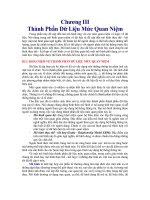Chuong 3 udp
Bạn đang xem bản rút gọn của tài liệu. Xem và tải ngay bản đầy đủ của tài liệu tại đây (2.88 MB, 32 trang )
Chapter 11
User Datagram
Protocol
Objectives
Upon completion you will be able to:
• Be able to explain process-to-process communication
• Know the format of a UDP user datagram
• Be able to calculate a UDP checksum
• Understand the operation of UDP
• Know when it is appropriate to use UDP
• Understand the modules in a UDP package
TCP/IP Protocol Suite
1
Figure 11.1 Position of UDP in the TCP/IP protocol suite
TCP/IP Protocol Suite
2
11.1 PROCESS-TO-PROCESS
COMMUNICATION
Before we examine UDP, we must first understand host-to-host
communication and process-to-process communication and the
difference between them.
The topics discussed in this section include:
Port Numbers
Socket Addresses
TCP/IP Protocol Suite
3
Figure 11.2 UDP versus IP
TCP/IP Protocol Suite
4
Figure 11.3 Port numbers
TCP/IP Protocol Suite
5
Figure 11.4 IP addresses versus port numbers
TCP/IP Protocol Suite
6
Figure 11.5 ICANN ranges
TCP/IP Protocol Suite
7
Note:
The well-known port numbers are less
than 1024.
TCP/IP Protocol Suite
8
Table 11.1 Well-known ports used with UDP
TCP/IP Protocol Suite
9
Example 1
In UNIX, the well-known ports are stored in a file called
/etc/services. Each line in this file gives the name of the server
and the well-known port number. We can use the grep utility to
extract the line corresponding to the desired application. The
following shows the port for TFTP. Note TFTP can use port 69
on either UDP or TCP.
$ grep tftp /etc/services
tftp
69/tcp
tftp
69/udp
See Next Slide
TCP/IP Protocol Suite
10
Example 1 (Continued)
SNMP uses two port numbers (161 and 162), each for a
different purpose, as we will see in Chapter 21.
$ grep snmp /etc/services
snmp
161/tcp
snmp
161/udp
snmptrap 162/udp
TCP/IP Protocol Suite
#Simple Net Mgmt Proto
#Simple Net Mgmt Proto
#Traps for SNMP
11
Figure 11.6 Socket address
TCP/IP Protocol Suite
12
11.2 USER DATAGRAM
UDP packets are called user datagrams and have a fixed-size header of 8
bytes.
TCP/IP Protocol Suite
13
Figure 11.7 User datagram format
TCP/IP Protocol Suite
14
Note:
UDP length =
IP length − IP header’s length
TCP/IP Protocol Suite
15
11.3 CHECKSUM
UDP checksum calculation is different from the one for IP and ICMP.
Here the checksum includes three sections: a pseudoheader, the UDP
header, and the data coming from the application layer.
The topics discussed in this section include:
Checksum Calculation at Sender
Checksum Calculation at Receiver
Optional Use of the Checksum
TCP/IP Protocol Suite
16
Figure 11.8 Pseudoheader for checksum calculation
TCP/IP Protocol Suite
17
Figure 11.9 Checksum calculation of a simple UDP user datagram
TCP/IP Protocol Suite
18
11.4 UDP OPERATION
UDP uses concepts common to the transport layer. These concepts will be
discussed here briefly, and then expanded in the next chapter on the TCP
protocol.
The topics discussed in this section include:
Connectionless Services
Flow and Error Control
Encapsulation and Decapsulation
Queuing
Multiplexing and Demultiplexing
TCP/IP Protocol Suite
19
Figure 11.10 Encapsulation and decapsulation
TCP/IP Protocol Suite
20
Figure 11.11 Queues in UDP
TCP/IP Protocol Suite
21
Figure 11.12 Multiplexing and demultiplexing
TCP/IP Protocol Suite
22
11.5 USE OF UDP
We discuss some uses of the UDP protocol in this section.
TCP/IP Protocol Suite
23
11.6 UDP PACKAGE
To show how UDP handles the sending and receiving of UDP packets,
we present a simple version of the UDP package. The UDP package
involves five components: a control-block table, input queues, a controlblock module, an input module, and an output module.
The topics discussed in this section include:
Control-Block Table
Input Queues
Control-Block Module
Input Module
Output Module
TCP/IP Protocol Suite
24
Figure 11.13 UDP design
TCP/IP Protocol Suite
25









